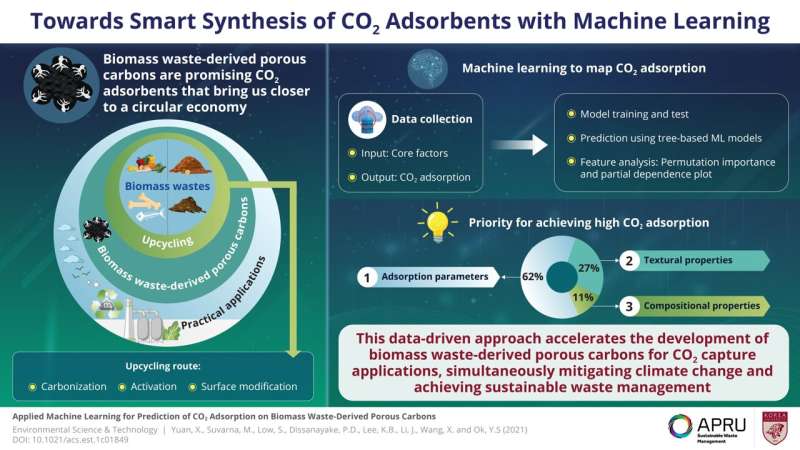Leveraging machine learning to optimize CO2 adsorption

If we are to mitigate climate change, we must find cost-effective and sustainable ways to reduce industrial carbon dioxide (CO2) emissions. Unfortunately, most well-established methods for carbon capture and storage (CCS) in industrial post-combustion sources bear significant downsides, such as a high cost, environmental toxicity, or durability issues. Against this backdrop, many researchers have focused on what may be our best bet for next-generation CCS systems: CO2 adsorption using solid porous carbon materials.
One notorious advantage of using porous carbons for CO2 sequestration is that they can be produced from biomass waste, such as agricultural waste, food waste, animal waste, and forest debris. This makes biomass waste-derived porous carbons (BWDPCs) attractive not only due to their low cost, but also because they provide an alternative way to put biomass waste to good use. Although BWDPCs could definitely bring us closer to a circular economy, this field of study is relatively young, and no clear guidelines or consensus exist between scientists as to how BWDPCs should be synthesized or what material properties and compositions they should strive for.
Could artificial intelligence (AI) help us out in this conundrum? In a recent study published in Environmental Science and Technology, a collaborative research team from Korea University and the National University of Singapore employed a machine learning-based approach that may guide the development of future porous carbon synthesis strategies. The scientists noted that there are three core factors influencing the CO2 adsorption properties in BWDPCs: the elemental composition of the porous solid, its textural properties, and the adsorption parameters at which it operates, such as temperature and pressure. However, how these core factors should be prioritized when developing BWDPCs has remained unclear, until now.
To help settle this matter, the team first conducted a literature review and selected 76 publications describing both the synthesis and performance of various BWDPCs. After curation, these papers provided over 500 datapoints that were used to train and test three tree-based models. "The main purpose of our work was to elucidate how machine learning tools can be leveraged for predictive analytics and used to draw valuable insights into the process of CO2 adsorption using BWDPCs," explains Professor Yong Sik Ok from Korea University, who led the study.
The input features of the models were the three core factors, whereas the output was the level of CO2 adsorption. Although the models themselves become essentially 'black boxes' after the training process, they can be used to make accurate predictions on the performance of BWDPCs based solely on the core factors considered. Most importantly, through feature analyses, the research team determined the relative importance of each of the input features for making accurate predictions. In other words, they established which of the core factors is the most important to achieve high CO2 adsorption. The results indicate that the adsorption parameters contributed much more than the other two core factors for the models to make correct predictions, underlining the importance of optimizing operational conditions first. The textural properties of the BWDPCs, such as their pore size and surface area, came in second place, and their elemental composition came last.
Worth noting, the predictions of the models and the results of the feature importance analyses were backed by existing literature and our current understanding of the mechanisms behind the CO2 capture process. This cemented the real-world applicability of this data-driven strategy not only for BWDPCs, but for other types of materials, as Prof. Ok explains, "Our modeling approach is cross-deployable and can be used to investigate other types of porous carbons for CO2 adsorption, such as zeolites and metal−organic frameworks, and not just those derived from biomass waste."
The team now plans to devise a synthesis strategy for BWDPCs by focusing on optimizing the two most important core factors. Moreover, they will keep adding experimental data points to the database used in this study and make it open source so that the research community may also benefit from it.
More information: Xiangzhou Yuan et al, Applied Machine Learning for Prediction of CO2 Adsorption on Biomass Waste-Derived Porous Carbons, Environmental Science & Technology (2021). DOI: 10.1021/acs.est.1c01849

















